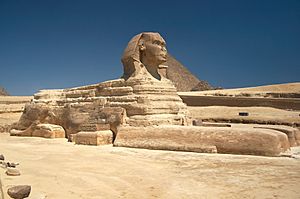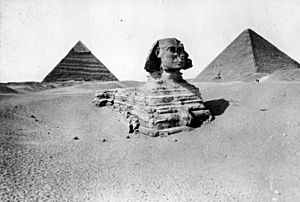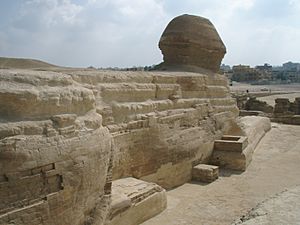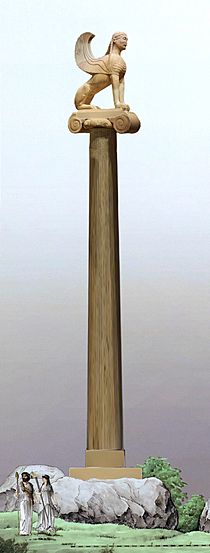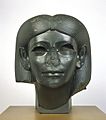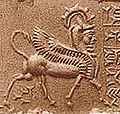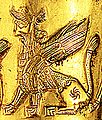Sphinx facts for kids
|
The Great Sphinx of Giza, with the Great Pyramid in the background
|
|
| Grouping | Legendary creatures |
|---|---|
| Similar creatures | Griffin, Manticore, Cherub, Lamassu, Narasimha |
| Mythology | Persian, Egyptian and Greek |
A sphinx is a mythical creature. It usually has the head of a human and the body of a lion. Sphinxes appear in myths from different cultures, like ancient Egypt, Greece, and Persia. They are often seen as powerful guardians.
In Greek stories, the sphinx is a monster with a woman's head, a lion's body, and bird wings. She was known for being tricky and dangerous. If someone couldn't answer her riddle, she would kill and eat them. This scary sphinx appears in the famous story of Oedipus.
Unlike the Greek sphinx, which was female, the Egyptian sphinx is usually shown as a man. This male sphinx is called an androsphinx. Egyptian sphinxes were seen as kind guardians, but they were also very strong. Both Greek and Egyptian sphinxes often stood at the entrances of temples to protect them.
The idea of the sphinx became popular again in European art during the Renaissance. Over time, the sphinx image spread to many other cultures. People often understood the sphinx differently based on their own traditions. Sphinx pictures are usually found near important buildings like royal tombs or religious temples. The oldest known sphinx was found in Turkey and is about 11,500 years old!
Contents
Sphinxes in Ancient Egypt
The most famous sphinx is the Great Sphinx of Giza. It is located near the Great Pyramids of Giza on the west bank of the Nile River. The Sphinx faces east. Most experts believe the head of the Great Sphinx looks like the pharaoh Khafre.
We don't know what names the builders gave to these huge statues. An old inscription from 1400 BCE mentions the local sun deity of that time. Many pharaohs had their faces carved onto guardian statues. This showed their connection to the powerful lioness goddess Sekhmet.
Besides the Great Sphinx, other famous Egyptian sphinxes exist. One has the head of the pharaoh Hatshepsut and is made of granite. It is now in the Metropolitan Museum of Art in New York. Another is the alabaster sphinx of Memphis, found in Memphis, Egypt.
Sometimes, long avenues of guardian sphinxes led to tombs and temples. For example, nine hundred sphinxes with ram heads were built in Thebes. These represented the god Amun. The Great Sphinx is now a symbol of Egypt. You can often see it on their stamps, coins, and official papers.
Sphinxes in Greek Myths
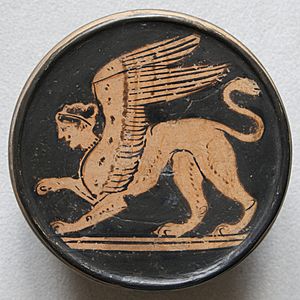
In the Bronze Age, the Greeks traded and shared ideas with Egypt. Even before Alexander the Great took over Egypt, the Greek word sphinx was used for these statues. Greek historians wrote a lot about Egyptian culture. Herodotus called ram-headed sphinxes Criosphinxes. He called hawk-headed ones Hieracosphinxes.
The word sphinx comes from the Greek word sphíngō. This means "to squeeze" or "to tighten up." This might be because lionesses, who are the hunters in a pride, kill their prey by strangling them. However, some historians think "sphinx" might be a Greek version of the Egyptian name "shesepankh." This meant "living image" and referred to the statue carved from "living rock."
Apollodorus described the Greek sphinx. It had a woman's face, a lion's body and tail, and bird wings. Pliny the Elder said that Ethiopia had many sphinxes with brown hair and breasts. The poet Statius described her as a winged monster. Sometimes, her wings were like an eagle, and her tail was like a snake.
There was only one sphinx in Greek mythology. She was a unique demon of destruction and bad luck. She was often said to be the daughter of scary, ancient gods. The Sphinx was also called Phix by the poet Hesiod. The sphinx was an important symbol for the ancient Greek city-state of Chios. It appeared on their coins for many centuries.
The Famous Riddle
The Sphinx was said to guard the entrance to the Greek city of Thebes. She would ask a riddle to travelers. If they answered correctly, she would let them pass. If not, she would kill them. The exact riddle wasn't always the same in early myths. It became standardized later in Greek history.
It was said that the goddess Hera or the god Ares sent the Sphinx to Thebes. She asked everyone the most famous riddle: "Which creature has one voice and yet becomes four-footed and two-footed and three-footed?" She would strangle and eat anyone who couldn't answer.
Oedipus was the one who solved the riddle. He answered: "Man." He explained that a man crawls on all fours as a baby. Then he walks on two feet as an adult. Finally, he uses a walking stick, becoming "three-footed," in old age.
Sometimes, there was a second riddle: "There are two sisters: one gives birth to the other and she, in turn, gives birth to the first. Who are the two sisters?" The answer is "day and night." This second riddle might be very old.
After Oedipus solved the riddle, the Sphinx was defeated. She then threw herself off her high rock and died. In some stories, Oedipus killed her. Because Oedipus defeated the Sphinx, he helped bring about a change. It was like moving from old religious ways to the new gods of Olympus.
Sphinxes and Freemasonry
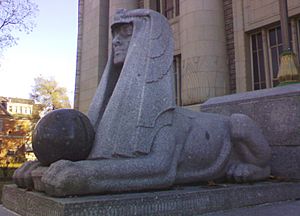
The image of the sphinx has been used in Masonic buildings and symbols. In ancient Egypt, sphinxes were placed at temple entrances. They guarded the temple's secrets. They warned people to keep what they learned hidden from those who weren't allowed to know.
A scholar named Champollion said the sphinx became a symbol for different gods. Placing sphinxes showed that the gods were hidden from most people. Only special members were taught about them.
In Freemasonry, the sphinx is a symbol of mystery. You can often see sphinx statues in front of Masonic temples. They are also sometimes engraved on Masonic documents.
Images for kids
-
The Sphinx of Naxos, on its 12.5-meter Ionic column, Delphi, 560 BC (reconstitution).
-
Male purushamriga or Indian sphinx guarding the entrance of the Shri Shiva Nataraja temple in Chidambaram
-
Funerary stele, 530 BC, Greece.
-
Winged sphinx from the palace of Darius the Great during Persian Empire at Susa (480 BC)
-
Achaemenid sphinx from Halicarnassus, capital of Caria, 355 BC. Found in Bodrum Castle, but possibly from the Mausoleum at Halicarnassus.
-
Head from a female sphinx, c. 1876–1842 BC, Brooklyn Museum
-
The Great Sphinx of Giza in 1858
-
Typical Egyptian sphinx with a human head (Museo Egizio, Turin)
-
Sphinx of Egyptian pharaoh Hatshepsut with unusual ear and ruff features, 1503–1482
-
Ancient Greek sphinx from Delphi
-
3000-year-old sphinxes were imported from Egypt to embellish public spaces in Saint Petersburg and other European capitals.
-
Classic Régence garden Sphinx in lead, Château Empain, the Parc d'Enghien, Belgium
-
The Sphinx of Adi Gramaten, Eritrea
-
Wings of sphinxes from the Thinissut sanctuary, c. 1st century AD (Nabeul Museum, Tunisia)
-
An early Egyptian sphinx, Queen Hetepheres II from the Fourth Dynasty (Cairo Museum)
-
An Iranian Luristan Bronze in the form of a Gopat, currently in the Cleveland Museum of Art.
See also
 In Spanish: Esfinge (mitología) para niños
In Spanish: Esfinge (mitología) para niños


